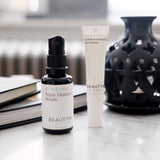
Everyone knows that the sun’s ultraviolet rays can harm a person’s skin, but what about sunless self-tanners? The effects of a sun tan from a bottle might seem a little questionable, so we asked Dr. Schultz for the low-down on self-tanners and if they have any negative side effects.
How do they work?
Spray tans temporarily stain the dead cells on the surface of your skin. When applied, the active ingredient dihydroxyacetone (DHA) reacts with the skin’s surface and temporarily simulates a suntan. These lotions, creams, and sprays are able to provide you with tan skin without harmful UV rays.
Are they safe?
“A sunless tanner is much, much safer than any ultraviolet induced tan,” said Dr. Schultz. The biggest misconception of self-tanners is that they aren’t safe to use. But there is no evidence to believe that dihydroxyacetone (DHA) is not completely safe for humans. The self-tanner track record is clean, as it has been used for over 30 years without any association with skin cancer.
Any precautions?
Take measures to ensure that you do not inhale the fumes from a spray-tan. Wearing protective eye goggles, lip balm, and nose plugs will help prevent the inhalation of spray tan fumes. The same approach to avoid inhaling spray-on deodorant should be used when it comes to spray tans.
The stigma around spray tans is unnecessary and we recommend that they are the safest way to tan. Any tanning experience that includes UV rays can be harmful to the appearance of your skin. Don't forget to exfoliate the skin before self-tanning like our Daily Exfoliating Body Lotion to ensure a smooth, even tan.
 BRX REWARDS
BRX REWARDS






















Leave a Comment